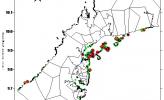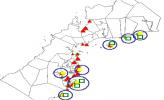The extent of City’s coastline stretches to 416 kilometers and its municipal coastal waters within the 15-km boundary cover an area of 327,586 hectares. Around 74% of its barangays are located in the coastal lands wherein most of its households are involved in fishing.
There are three bays located in Puerto Princesa City. Two are situated on the eastern side: Puerto Princesa Bay and Honda Bay and one on the northwestern side, the Ulugan Bay.
One of the major fishing grounds in the City is Honda bay whose fish catch has been declining. In 1985, the reported fish catch per trip was 36.5 kg and this went down to 8.4 kg in 1989 or a reduction of 76% and further dove to 5.0 kg in 1996. The decline in fishery yield per unit effort was due to overfishing and destruction of marine habitats brought about by blast fishing, illegal fishing gears, erosion and siltation.
Coral Reefs
The Marine Team of the ECAN Zoning Project conducted a Manta Tow survey of the coral reefs covering the entire length of the coastline of Puerto Princesa City. On the western side of the City’s coastal areas, a large portion of the corals observed was dead. The dead reefs were colonized by thick vegetation of Sargassum. The predatory seastar crown-of-thorns (COT) was also noted to be more abundant at the western section (between Sabang and Ulugan Bay).
Two areas in the western coast of the City were found to have good coral cover: Pinanganakan Island, a small island located northward, and a small area southward in the vicinity of Napsan. Despite the poor condition of the reefs on the western seaboard, more sea turtles and sharks were encountered by the Marine survey team during their survey, especially towards Ulugan Bay.
On the other hand, most of the coral reefs found on the eastern coast of Puerto Princesa City have good to excellent cover. Soft corals are also abundant on the eastern seaboard. Honda bay has a large area covered by soft corals. Likewise, an area in Kamuning had a soft coral cover of more than 50%. Hard and soft corals were found in equal proportion in some of the areas surveyed in the eastern side of the City’s coastal areas.
Figure shows the status of hard and soft coral reef cover in the sites surveyed by the team in April 2005. Coral reefs with more than 50% hard cover are mostly located in the eastern coast within Honda bay. Coral reefs in Puerto Princesa bay are mostly in poor condition with a coral cover ranging from 11-30%.
Reef Fish
The Marine Survey Team covered a total of 86 sampling stations located at both east and west coast of Puerto Princesa City to assess the status of reef fish in the area. The sampling sites or stations selected were mainly situated at or near the reef crest where most of the fish occur. The Consultant and his team also traversed reef flats and reef slopes to cover a wider area of the reef zones. A variety of reef fish habitats were surveyed to generate a good species count. Thus, the benthic cover, dominant substrate, dominant stands of coral, Sargassum beds, sandy areas and rocky reefs were noted in the survey.
The team was able to identify and list a total of 293 species of fish distributed among 42 families from all the sampling stations combined. The most speciose family recorded is the damselfishes (Pomacentridae) with 53 species followed by the Labridae with 45 species, parrotfishes (Scaridae) with 23 species, and the butterflyfishes Chaetodontidae with 21 species.
Of the total species listed, 25 were indicator species, 128 were major species and 140 were target species. The presence of indicator species is used to determine the health condition of the habitat. Although they do not have commercial value, the major species play an important role in the food web of marine organisms. The commercially valuable reef fish species are the target fish.
The survey noted that the target fishes were the most speciose among the three fish categories with 140 species from 25 families. This is a surprising find since most of the target fishes in other municipalities surveyed by the team were the first to be depleted. However, the highly valued grouper Plectropomus leopardus was only observed in 12 or 14% of the total sampling stations surveyed.
Some of the dominant target species observed in the survey were parrotfishes, surgeonfishes (Acanthuridae), goatfishes (Mullidae), snappers (Lutjanidae), rabbitfishes (Siganidae), threadfin breams (Nemipteridae), emperor breams (Lethrinidae), triggerfishes (Balistidae), fusiliers (Caesionidae) and groupers (Serranidae).
Among the 86 sampling sites or stations surveyed, species richness ranged from 2 to 75 species per 250 sq.m. with a mean of 28 species per 250 sq.m. The site with the highest species richness is Jacana, which is situated in front of the airport and a military detachment. The site has a high live coral cover of mostly tabulate Acropora and massive and encrusting coral life forms. In contrast, two stations on the west coast registered the lowest species richness.
The overall finding of the survey revealed that species richness is higher in the east coast where Honda and Puerto Princesa bays are located than in the west coast where Ulugan bay is located. The low species richness observed in almost all the sampling points at the west coast may be a result of the reported “red tide and fish kill” events that occurred in March 2005 which was only a month before the survey was done. During the survey at the west coast, “clouds” of dense masses of plankton were still evident in areas from Napsan to Marufinas. The plankton masses were especially dense and wide inside Ulugan Bay.
The higher species richness in the east coast was also attributed by the Marine consultants to good water visibility, protective management and the presence of law enforcing institutions at the east coast. In contrast, very poor water visibility (nearly zero at some points), and the recent episode of “fish-kill/red tide” at the west coast may have resulted in the very low species richness in the area.
The problems confronting the reef fish in Puerto Princesa’s bays include destructive fishing methods, siltation coming from denuded hilly areas and pollution from households especially coastal communities squatting in the shore lands.
The burgeoning population caused by heavy in-migration has manifested its toll to the coastal habitats in the east and west coast of the City. Overfishing is evident in the fishing grounds within the coastal jurisdiction of the City.
SeaWeeds and SeaGrass
The Marine Survey Team conducted the survey of seagrass cover, condition and species richness in selected sites of Puerto Princesa coastal waters in May 2005. The survey covered 95 sampling stations along the more than 400 km coastline of mainland Puerto Princesa. A total of 16 stations were also distributed in 11 islands within Honda Bay.
The team found wide and dense seagrass meadows in the southeast of Inagawan and within Puerto Princesa Bay particularly in Mangingisda, Iwahig, and Bancao-Bancao. Good cover of seagrass was also observed in Honda Bay from San Pedro to Tagburos, Luli Island, and Tadio/ Pundeado Island. A lush meadow was also found in deeper waters off Concepcion to Binduyan. These areas have more 50% seagrass cover indicating an overall healthy condition of the seagrass habitat.
In contrast, poor seagrass cover was noted in some parts of Honda bay, namely: Sta. Lucia, Sta Lourdes, Bacungan, Sta Cruz, Salvacion, San Rafael. Seagrass cover in these areas was attributed to their silty condition. The inner part of Ulugan bay was also noted to harbor sparse seagrass cover.
The coastal waters of Puerto Princesa City have eight species of seagrasses: Enhalus acoroides and Thalassia hemprichii were cosmopolitan, Halophila ovalis Cymodocea rotundata, Halodule uninervis (here including Halodule pinifolia), and Syringodium isoetifolium were the commonly associated species, and Cymodocea serrulata and an undetermined species of Halophila occurred less frequently.
Monospecific stands of E. acoroides are common in silted sampling sites in Honda Bay specifically in Bacungan, Sta Cruz, Bush Island in Salvacion and in Ulugan Bay (Bahile). Sampling stations with the highest diversity of seagrass (i.e., 8 species) are Inagawan, San Pedro, Bancao-Bancao, Tagburos, Cowrie Island (Sta Lourdes), and Buenavista (Ulugan Bay). Seaweeds associated with seagrass beds contributed up to 30% of total vegetative cover and were represented by 24 genera, three of which were commonly encountered – the brown seaweeds Sargassum and Padina, and the green algae Halimeda.
Figure shows the potential sites for core zoning of seagrass beds. The selection of areas for core zone was based on the combination of ecological characters: seagrass species richness (triangles), bottom cover (green circles; yellow circles are well-covered beds), and presence of dugong graze marks (squares.
The survey team found grazes marks of Dugong in Kamuning, Inagawan, Mangingisda, Pundeado Island (Babuyan), Tanabag to Concepcion, and Binduyan. The sites where Dugong grazing marks were found are potential sites for core zoning.
From the combination of ecological characters (relatively high bottom cover and seagrass species richness) and apparent habitat use to a suite of animals (fish and large mammals), the team proposes areas within Kamuning, Inagawan, Mangingisda, Iwahig, Bancao-Bancao, San Pedro, Tagburos, Pundeado Island, Cowrie Island, and Buenavista as among the high-priority list of seagrass ECAN core zones, and adjacent areas within Mangingisda, Luzviminda, Bancao-Bancao, San Manuel, Manalo, Tadio Island, Macarascas, and Buenavista as among the potential (‘reserved’) candidate areas. The latter are put forward in view of current global efforts on biodiversity conservation.

